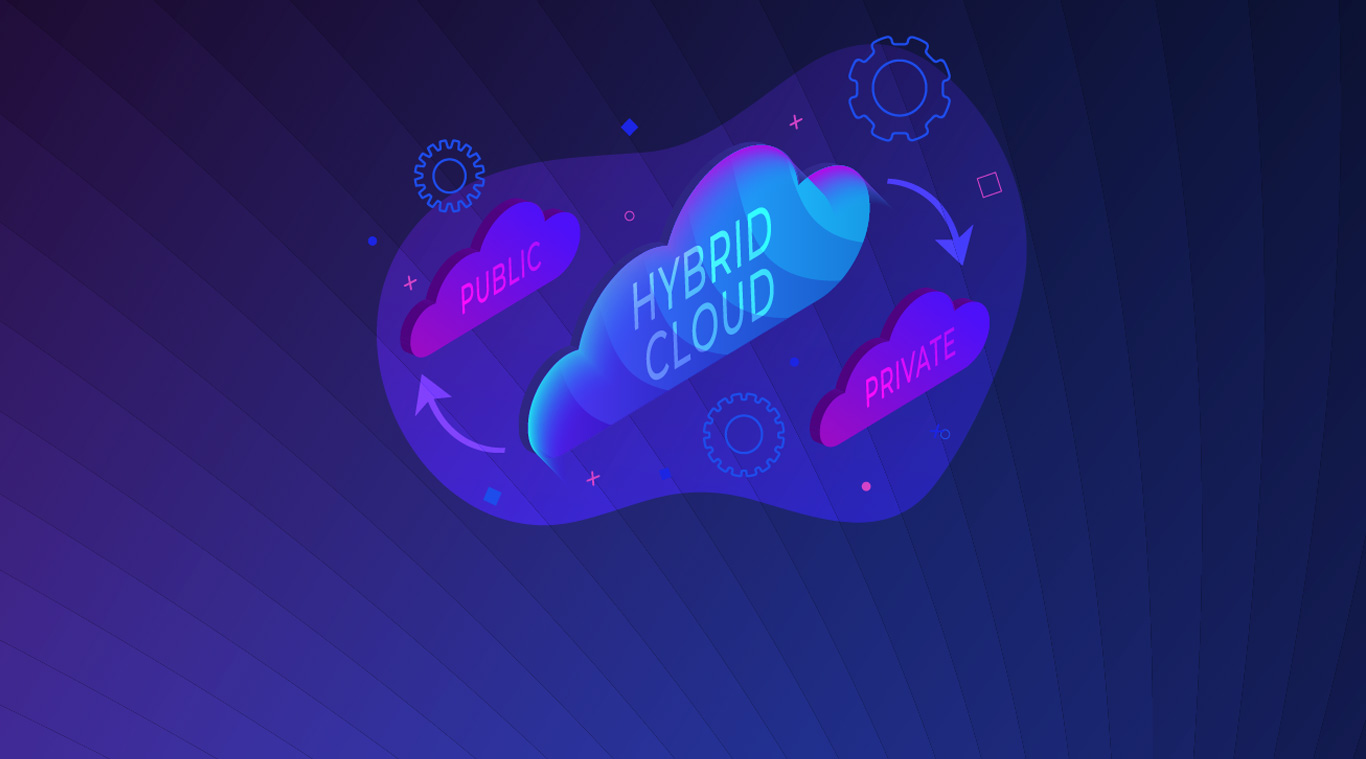What to Consider for a Data Centre Service Partner
Organisations are on a perennial quest to reduce costs and increase their business focus with the power of data. There is an increased emphasis on unleashing the full potential of technology with the Data Centre (DC) and the corroborating IT infrastructure. Organisations are increasingly looking forward to unlocking data-driven transformation by partnering with the right Data Centre service providers for organisational resilience, business continuity, and cost savings.
The pandemic has further pushed for the growth in digital adoption and IT-infra trends where enterprises are largely gravitating towards colocation and cloud rather than in-house DC. With flexibility, scalability, and state-of-the-art security being guaranteed, they need a reliable and trustworthy partner who can go beyond their basic Data Centre requirements.
Choosing Your Ideal Data Centre Service Partner
There are many factors to consider when choosing a data centre partner but here are our suggestions based on our experience:
- Dedicated Subject Matter Experts across all functions in each Data Centre including Electrical, Mechanical, Building Management System, Health & Safety, Security and Network.
- Cross-industry experience in hosting diverse workloads on carrier-neutral Data Centres.
- Data Centre presence across all regions to serve customers effectively.
- Stringent physical infrastructure security.
- Green Data Centres with energy-efficient devices and processes to reduce energy consumption.
- Sourcing and deploying renewable energy.
- Strong Environmental Health & Safety (EHS) policies.
- Redundant architecture for high resiliency.
- Backup and Disaster Recovery capabilities.
- Partnership with leading Hyperscale Cloud Providers.
- Fast Network connectivity to multiple public clouds.
- Experience in optimising hybrid cloud.
An ideal provider should have a partnership with leading hyperscalers, connectivity to respective public clouds, and experience of optimising the hybrid cloud. With increasing emphasis on environmental safety and sustainability, it is best if your provider uses green data centres which use renewable energy for reducing water usage, electricity consumption, and harmful emissions. A quick way of judging a provider is to look at the overall customer feedback for its services.
Sify Data Centres – Your Ideal Data Centre Transformation Partner
Being the very first Data Centre Colocation Service Provider in India, Sify has a rich experience of 20 years in building, owning, and operating Data Centres. Owing to its operational experience and efficiency, it has been ensuring 100% uptime for its customers since 2008. Sify has 10 operational data centres spread across all major Indian cities – Mumbai, Bengaluru, Hyderabad, Noida, Kolkata, and Chennai with 70 MW IT power capacity. Thus, customers have the flexibility of choosing a DC close to their location, expanding business to new geographies, and selecting multiple DR sites in different seismic zones for high resiliency. Additionally, Sify has a roadmap of adding another 200 MW in the next four years to address the increasing demands of its customers.
Experience Sify Data Centres in 360-degree Virtual Reality

Sify’s carrier-neutral Data Centres are equipped with multiple Internet Exchanges such as AMS-IX, Extreme IX, NIXI, etc for facilitating OTTs, ISP interconnects, and Content IP peering. This allows customers to reach multiple Cloud Service Providers (CSPs) and select the most compatible CSP for accelerating their data processing and storage efficiency. In addition, Sify’s massive Data Centre and Network ecosystem connect more than 48 Interconnected Data Centres across India. Sify Data Centres hosts Hyperscaler Cloud Providers with their Cloud Connects enabling cloud adjacency for the hybrid cloud. Customers can leverage the above for faster access to cloud applications and scalability of critical processes enabled by the Hybrid Cloud architecture.
Sify Data Centres have multiple security layers as per global standards for extremely high data security. Keeping ahead of the curve, they feature multiple fibre paths to counter evolving security threats. Sify Data Centres are certified as per ISO 27001:2013, ISO 20000-1:2011 and ISO 9001:2008 as well as SOC 2 reporting, TIA 942 Rated 3, PCI DSS, and SAP HANA. These qualifications have compelled customers to choose Sify as their first choice for a secure and safe infrastructure for hosting in India.
To enable a seamless experience, Sify also offers cross-connects and rack space deployment services through an easy-to-use self-service portal. Sify Data Centres have been entrusted by industry leaders from BFSI, manufacturing, e-commerce, ITeS, healthcare, media, and many more. Sify Data Centres address all your data centre requirements for accelerating your digital journey including Colocation, Data Centre consolidation/expansion, Disaster Recovery, and Hybrid Cloud.
Build Your Bespoke Environment in India
India is one of the largest and fastest-growing markets for digital consumers. An entire ecosystem of primary and associated services is benefiting from this rapid change. The data centre has become the epicentre of Cloud and Digital Transformation in the region.
As the pioneer in data centre services in India, Sify was one of the first service providers to offer Managed Hosting Services, Colocation Services and Enterprise-ready Cloud Services, serving customers since 1995.
Sify will help you build your bespoke service environment in any of our ten data centres across the Indian subcontinent.
Learn more about our Data Centre Services

Shifting Mindsets: Adopting a Compliance Journey
Read the Shifting Mindsets: Adopting A Compliance Journey White Paper to learn more.
SAP Migrations to AWS Cloud using Cloud Endure Migration Tool
Enterprises migrating SAP workloads to AWS are looking for an as-is migration solution that are readily available. Earlier, enterprises used the traditional method of SAP backup and restore for migration or AWS-native tools such as AWS Server Migration Service to perform this type of migration. CloudEndure Migration is a new AWS-native migration tool for SAP customers.
Enterprises looking to host a large number of SAP systems onto AWS can use CloudEndure Migration without worrying about compatibility, performance disruption or long cutover windows. You can perform any re-architecture after your systems start running on AWS.
Solution Overview
CloudEndure Migration simplifies, expedites and reduces the cost of such migrations by offering a highly automated as-is migration solution. This blog demonstrates how easy it is to set up CloudEndure Migration and the steps involved in migrating SAP systems from source to AWS environment.
CloudEndure Migration Architecture
The following diagram shows the CloudEndure Migration architecture for migrating SAP systems.
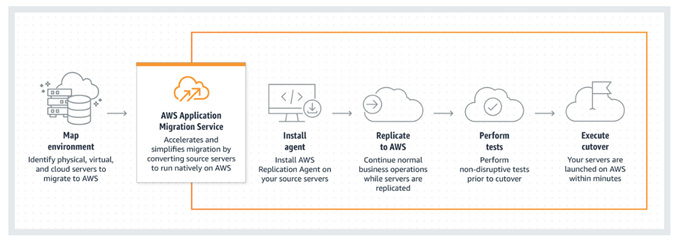
Major steps for this migration are as below:
- Agent Installation
- Continuous Replication
- Testing and Cutover
CloudEndure helps you overcome the following migration challenges effectively:
- Diverse infrastructure and OS type
- Legacy application
- Complex database
- Busy continuously changing workloads
- Machine compatibility issues
- Expensive cloud skills required
- Downtime and performance disruptions
- Tight project timelines and limited budget
Use Cases
The most common uses cases for CloudEndure Migration are:
- Lift and Shift, then optimize
- Vast majority of Windows/Linux servers when agent can be installed on source machine
- Replicating Block Storage devices like SAN, iSCSI, Physical, EBS, VMDK, VHD
- Replicating full machine/volume
Benefits
Access to advanced technology
Simplify operations and get better insights with AWS Application Migration Services integration with AWS Identity and Access Management (IAM), Amazon CloudWatch, AWS CloudTrail, and other AWS Services.
Minimal downtime during migration
With AWS Application Migration Service, you can maintain normal business operations throughout the replication process. It continuously replicates source servers, which means little to no performance impact. Continuous replication also makes it easy to conduct non-disruptive tests and shortens cutover windows.
Reduced costs
AWS Application Migration Service reduces overall migration costs as there is no need to invest in multiple migration solutions, specialized cloud development, or application-specific skills. This is because it can be used to lift and shift any application from any source infrastructure that runs supported operating systems (OS).
Conclusion
This blog discussed how Sify can help its SAP customers migrating to AWS Cloud using CloudEndure tool. Sify would be glad to help your organization as your AWS Managed Services Partner for a tailor-made solution involving seamless cloud migration experience and for your Cloud Infrastructure management thereafter.
CloudEndure Migration software doesn’t charge anything as a license fee to perform automated migration to AWS. Each free CloudEndure Migration license allows for 90 days of use following agent installation. During this period, you can start the replication of your source machines, launch target machines, conduct unlimited tests, and perform a scheduled cutover to complete your migration.
Automated Recovery of SAP HANA Database using AWS native options
This blog exclusively covers the options available in AWS to recover SAP HANA Database with low cost and without using native HSR tool of SAP. With a focus on low costs, Sify recommends choosing a cloud native solution leveraging EC2 Auto Scaling and AWS EBS snapshots that are not feasible in an on-premises setup.
Solution Overview
The Restore process leveraging Auto Scaling and EBS snapshots works across availability zones in a region. Snapshots provide a fast backup process, independent of the database size. They are stored in Amazon S3 and replicated across Availability Zones automatically, meaning we can create a new volume out of a snapshot in another Availability Zone. In addition, Amazon EBS snapshots are incremental by default and only the delta changes are stored since the last snapshot. To create a resilient highly available architecture, automation is key. All steps to recover the database must be automated in case something fails or goes wrong.
Autoscaling Architecture
The following diagram shows the Auto Scaling architecture for systems in AWS.
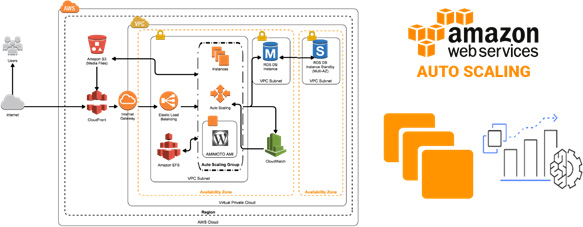
Use Case
EBS Snapshots
Prior to enabling EBS snapshots we must ensure the destination of log backups are written to an EFS folder which is available across Availability Zones.
Create a script prior to the command to be executed for an EBS snapshot. By using the system username and password, we make an entry into the HANA backup catalog to ensure that the database is aware of the snapshot backup. We use the snapshot feature to take a point in time and crash consistent snapshot across multiple EBS volumes without a manual I/O freeze. It is recommended to take the snapshot every 8-12 hours.
Now the log backups are stored in EFS and full backups as EBS snapshots in S3 and both sets are available across AZs. Both storage locations can be accessed across AZs in a region and are independent of an AZ.
EC2 Auto Scaling
Next, we create an Auto Scaling group with a minimum and maximum of one instance. In case of an issue with the instance, the Auto Scaling group will create an alternative instance out of the same AMI as the original instance.
We first create a golden AMI for the Auto Scaling group and the AMI is used in a launch configuration with the desired instance type. With a shell script in the user data, upon launch of the instance, new volumes are created out of the latest EBS snapshot and attached to the instance. We can use the EBS fast snapshot restore feature to reduce the initialization time of the newly created volumes.
If the database is started now (recently), it would have a crash consistent state. In order to restore it to the latest state, we can leverage the log backup stored in EFS which is automatically mounted by the AMI. Additional Care to be taken so that the SAP application server is aware of the new IP of the restored SAP HANA database server.
Benefits
- Better fault tolerance – Amazon EC2 Auto Scaling can detect when an instance is unhealthy, terminate it, and launch an instance to replace it. Amazon EC2 Auto Scaling can also be configured to use multiple Availability Zones. If one Availability Zone becomes unavailable, Amazon EC2 Auto Scaling can launch instances in another one to compensate.
- Better availability – Amazon EC2 Auto Scaling helps in ensuring the application always has the right capacity to handle the current traffic demand.
- Better cost management – Amazon EC2 Auto Scaling can dynamically increase and decrease capacity, as needed. Since AWS has pay for the EC2 instances, billing model can be used to save money, by launching instances only when they are needed and terminating them when they aren’t.
Conclusion
This blog discussed how Sify can help SAP customers to save cost by automating recovery process for HANA database, using native AWS tools. Sify would be glad to help your organization as your AWS Managed Services Partner for a tailor-made SAP on AWS Cloud solution involving seamless cloud migration experience and for your Cloud Infrastructure management thereafter.
Fast-track your SAP’s Cloud Adoption on AWS, with Sify
Cloud computing (which later became known as just Cloud), one of the technology trends since last few years, has become a game-changer. Cloud offered a platform for organizations not just to host their applications but also to maintain it / manage it and charge organizations on a pay-per-usage model. This translated into getting rid of the Capex (Capital expenditure on hardware/servers) and instead, opting for the flexible Opex (Operating Expenses) model which also helped organizations in slashing the manpower budget.
The biggest advantage of Cloud is its scalability – freedom to add/reduce storage/compute/network bandwidth as per the need within an agreed SLA-framework.
The rise of Cloud adoption led to two categories:
- Cloud as a hosting platform
- Cloud-based software/applications
Cloud as a hosting platform
This is more popularly known as Platform-as-a-Service (PaaS) or Infrastructure-as-a-Service (IaaS) wherein the service provider offers bundled services of Compute, Storage, Network & Security requirements.
Cloud providers deliver a computing platform, typically including operating system, programming language execution environment, database, and web server. Application developers can develop and run their software solutions on a cloud platform without the cost and complexity of buying and managing the underlying hardware and software layers.
Based on the deployment options, Cloud is classified under Public, Private and Hybrid Cloud, which vary due to security considerations.
Why AWS
With some PaaS providers like AWS, the underlying compute and storage resources scale automatically to match application demand so that the cloud user does not have to allocate resources manually. They use a load balancer which distributes network or application traffic across a cluster of servers. Load balancing improves responsiveness and increases availability of applications.
As per a 2020 IDC study, over 85% of customers report cost reduction by running SAP on AWS.
Get consulting support, training, and services credits to migrate eligible SAP workloads with the AWS Migration Acceleration Program (MAP).
AWS has been running SAP workloads since 2008, meaningfully longer than any other cloud provider. AWS offers the broadest selection of SAP-certified, cloud-native instance types to give SAP customers the flexibility to support their unique and changing needs.
Whether you choose to lift and shift existing investments to reduce costs, modernize business processes with native AWS services, or transform on S/4HANA, reimagining is possible with SAP on AWS.
When you choose AWS, you will be joining 5,000+ customers who trust the experience, technology, and partner community of AWS to migrate, modernize, and transform their SAP landscapes.
AWS & Sify collaboration
While AWS has been a global leader in Public Cloud services, in India Sify Technologies (one of the pioneers in the ICT domain & India’s first SSAE-16 Cloud certified provider) had designed its own Cloud called ‘CloudInfinit’ way back in 2013 and since then has been helping diverse organizations in moving their ERP applications, especially SAP workloads to its Cloud, seamlessly.
With Sify’s cloud@core strategy, customers can enjoy all facets of Cloud with complete visibility and control.
SIFY’s SAP deployment flexibility ON CLOUD

SAP on AWS hybrid cloud solutions
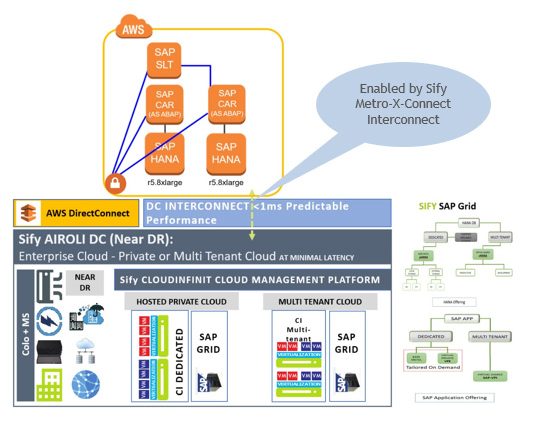
Use Cases
- Lifecycle Distribution: Separate Development and Test Environments
- Workload Distribution
- High Availability Deployments
Business Benefits
- Best of breed performance with Hybrid Cloud configuration
- Efficient integrations with extended ecosystems
- Compliance with data sovereignty
- Business continuity with resilience
- Simplicity with self service
- Operational efficiency with reduced IT administration
- Cost reduction with on-demand bursting to public clouds
Migration methodology
For SAP Migrations from on-premises or from any other Cloud to AWS, depending on various parameters like Prod. database size, available downtime window, source/target operating system/database, connectivity/link speed etc., we have been using various ways for seamless migration briefly explained below.

SAP SYSTEMS monitoring
Once SAP workloads are moved to AWS, Sify’s Managed Services takes care of every aspect, including monitoring the Operating System, Database, Connectivity, Security, Backup etc. as per the agreed SLAs. It also monitors the mission-critical SAP systems closely as depicted in diagram below.

Conclusion
Cloud, the scalable, flexible and yet robust hosting platform allows you to use your ERP workloads as well as SaaS applications effectively. Going by the increasing number of customers moving to Cloud, it is certain that Cloud is not vaporware, it is here to stay and only to grow bigger and safer by the day! It would also necessitate organizations to chart out a Smart Cloud strategy.
Embrace the Hybrid Cloud with VMC on AWS
According to Gartner, most of midsize and enterprise customers will be adopting a hybrid or a multi-cloud strategy. Companies have already realized that in order to move to public cloud, it is important to structure workload in hybrid cloud model.
Companies must understand that hybrid IT is not an easy methodology and therefore they must organize their existing IT resources and application workloads both on-premises and in public cloud efficiently to accomplish the goals of hybrid model. Additionally, they must also look for right skills for different private/public clouds and different sets of tools from respective cloud providers.
At Sify, we define some guidelines and structure to right fit your workloads in Hybrid Cloud. Please read on to know how Sify can help customers identify the right cloud (from the set of appropriate private and/or private clouds) for different sets of workloads.
Unique Challenges in Hybrid Cloud
In hybrid cloud, there are some unique challenges that businesses need to address first. key challenges that need to be addressed while designing solution on Hybrid Cloud are mentioned herein.
- Generally, it is very difficult to identify the most suitable cloud environment and manage the cost of different clouds.
- Though all cloud environments are powerful in providing features like scalability and elasticity, however the process of managing a hybrid cloud is quite a complex task.
- Security Risks: The threat of data breach or data loss is perhaps the biggest challenge faced during hybrid cloud adoption. Generally, companies prefer on-premises private cloud to protect data locally. However, in order to ensure top-tier security of data and applications on hybrid cloud, companies must draft robust data protection policies and procedures.
Identify Applications for Hybrid Cloud
It is very important to identify applications for hybrid cloud, and your decision must be based on application’s architecture, behavior and user accessibility. Below are some key points to remember while designing Hybrid Cloud strategy: –
- Consider the compatibility of applications before deciding whether you want to continue running the applications in an on-prem cloud environment or migrate them to Public Cloud.
- Identify the running cost/budget for an application and compare it with different cloud providers to choose the most suitable cloud platform that suits your budgetary outlines and business requirements.
- Pay due attention to licensing requirements before migrating to Public/Private Cloud because a minor loophole in this aspect can have a major impact on the overall business.
- Re-look experience of existing IT team to manage different Private/Public cloud seamlessly.
Why VMC on AWS as Hybrid Cloud Choice?
VMware Cloud (also called as VMC) on AWS brings VMware’s enterprise-class Software-Defined Data Centre software to the AWS Cloud and enables customers to run production applications across VMware vSphere-based private, public, and hybrid cloud environments, with optimized access to AWS services.
AWS is VMware’s preferred public cloud partner for all vSphere-based workloads. The VMware and AWS partnership delivers a faster, easier, and cost-effective path to the hybrid cloud while allowing customers to modernize applications enabling faster time-to-market and increased innovation.
New Amazon EC2 i3en.metal instances for VMware Cloud on AWS, powered by Intel Xeon Scalable processors, deliver high networking throughput and lower latency so you can migrate data centres to the cloud for rapid data centre evacuation, disaster recovery, and application modernization.
VMC on AWS can be the right choice because VMware is trusted as a trusted virtualization platform for many years in the industry and enterprise VMware ensures that all your applications run seamlessly. Plenty of companies are already running on VMware platform and have applications running on it. Below are some key identifiers for VMC on AWS:
- VMware SDDC is running on bare metal, which is delivered, operated, supported by VMware
- On-demand scalability and flexible consumption
- Full operational consistency with on-premises SDDC
- Seamless workload portability and hybrid operations
- Global AWS footprint, reach, and availability
- Native AWS services accessibility
How VMC on AWS Solution Works?
VMware Cloud on AWS infrastructure runs on dedicated, single tenant hosts provided by AWS in a single account. Each host is equivalent to an Amazon EC2 I3.metal instance (2 sockets with 18 cores per socket, 512 GiB RAM, and 15.2 TB Raw SSD storage). Each host is capable of running many VMware Virtual Machines (tens to hundreds depending on their compute, memory and storage requirements). Clusters can range from a minimum 3 hosts up to a maximum of 16 hosts per cluster. A single VMware vCenter server is deployed per SDDC environment.
How do We Access AWS Services?
For companies that are using VMware Cloud on AWS (VMC) as production environment for their business-critical application, it will require connectivity to an AWS account. This is enabled by an AWS elastic network interface which provides a 25Gbps connectivity between VMC and AWS. Applications deployed on VMC can leverage native AWS services for storage, EC2 instances, RDS Databases, load balancing and DNS routing, etc., providing customers with the best of both worlds. These native services can be accessed from applications deployed on VMC and include:
- Simple Storage Service (S3)
- Elastic File Service (EFS)
- Amazon Relational Database Service (RDS)
Sify’s Value Propositions to Help Customer Who are Looking for Hybrid Cloud Solutions
Sify has been in the Cloud industry since 2012 and has its own cloud for enterprise customers which can be tailored based on the requirement. Over the last few years, Sify has been involved in large enterprise customer requirement understanding, solutions & implementation across Private, Public & Hybrid Clouds.
Sify has dedicated, experienced and certified SMEs involved during solution stage and implementation and to provide operations services which will enable businesses to accelerate the adoption of Hybrid Cloud.
Our approach is to identify potential use cases for Hybrid Cloud options for VMC on AWS and native AWS services during the initial assessment and design phase, and we also suggest the most suitable services that can help customers meet the strategic goals. These services include the following:
- Discovery Workshop
- Assessment
- Build and Migrate
Feel free to contact us to provide your organization a tailored solutions with the required support across the various stages of the setup of VMC & AWS and migration of workloads.
Leveraging CloudEndure in the migration to AWS Cloud
With the increased demand in scalability and flexibility of the infrastructure for organization to ramp up and speed up the go-to-market approach, it has become necessary to adopt the Public Cloud which can tackle this challenge efficiently. Therefore, businesses are looking for simple, reliable, and rapid migration of on-premises workload to Public Cloud with minimal disruption. Sify, being an AWS Advance Partner, has successfully carried out many large cloud migrations for several customers using CloudEndure and the best practices it brings in.
CloudEndure is a SaaS service offering from AWS to migrate workload from any source (physical, virtual, or private/public cloud) to AWS, from one AWS region to other AWS account (within same Account), and across different AWS accounts. It uses block level continuous replication to replicate data on to the target AWS environment.
To replicate data from source machine to target machine, we need to install agent on the source machine and should have the required CloudEndure license for migration. The migration license has expiry date post which the data replication stops.
The Continuous Data Replication task is performed and pushed to the staging area (includes Replication Server, EBS Volume, S3 Storage, Subnets and IP). The CloudEndure Service Manager ensures the co-ordination among the Source Machine, Replication Server and the Target Server.
Three points of contact for CloudEndure’ s components with the external network:
- The CloudEndure Agent needs to communicate with the CloudEndure Service Manager.
- The CloudEndure Agent needs to communicate with the CloudEndure Replication Servers.
- CloudEndure Replication Servers need to communicate with the CloudEndure Service Manager and S3.
CloudEndure helps you overcome below migration challenges effectively:
- Diverse infrastructure and OS type
- Legacy application
- Complex database
- Busy continuously changing workloads
- Machine compatibility issues
- Expensive cloud skills required
- Downtime and performance disruptions
- Tight project timelines and limited budget
Best Migration Practices that CloudEndure recommends:
Planning
- Begin by mapping out a migration strategy that identifies clear business motives and use cases for moving to the cloud.
- Migrate in phases/waves or conduct a pilot light migration in which you start with the least business-critical workloads.
- Do not perform any reboots on the source machines prior to a cutover.
- When scheduling your cutover, ensure that you allow enough time for data replication to complete and for all necessary testing to be carried out.
Licensing
- Ensure that you have sufficient migration licenses for your project.
- CloudEndure Migration license is free for 90 days of use following agent installation on source machine.
- While the use of CloudEndure Migration is free, you will incur charges for any AWS infrastructure that is provisioned during migration and after cutover, such as compute (EC2) and storage (EBS) resources.
Testing
- Check and optimize the network needed for migration.
- Perform a test at least one week before you plan to migrate your source This time frame is intended for identifying potential problems and solving them, before the actual cutover takes place.
- Train the staff early on CloudEndure and mitigate any risk during testing phase only.
- Ensure connectivity to your target machines (using SSH for Linux or RDP for Windows) and perform acceptance tests for your application.
Successful Implementation
- Cutover the machine on planned date.
- Carry out the acceptance test for the application migrated and functionality.
- Remove Source machines from the console after the cutover has been completed in order to clean up the staging area, reduce costs, and remove no longer needed replication resource.
Use cases
The Most Common uses cases for CloudEndure Migration are:
- Lift and Shift, then optimize
- Vast majority of Windows/Linux server when agent can be installed on source machine
- Replicating Block Storage devices like SAN, iSCSI, Physical, EBS, VMDK, VHD
- Replicating full machine/volume
Conclusion
You must keep these above points in mind while migrating to AWS using CloudEndure to reap the desirable outcomes. Sify would be glad to help your organization as your AWS Managed Services Partner for a tailor-made solution involving seamless, cloud migration experience and for your Cloud Infrastructure management thereafter.
Why is Compliance Training Important in Business?
- Winning or retaining contracts that have safety or other compliance performance requirements.
- Enhancing brand image and reputation, which may attract more customers.
- Attracting the best talent who want to work for a company with a reputation and culture they can be proud of.
- Motivating employees with training and developing plans to be more productive and enjoy their roles.
6 Factors to Consider Ahead of Your Compliance Journey
- Get Leadership Buy-in
Your compliance journey must start with commitment from the leadership team to achieve behaviour change. Executives need to define and own the risk management process.
- Identify Risks
Risks to the organisation should be identified and prioritised. High-risk issues will require the greatest commitment to training and to achieve behavioural change. Low-risk issues should receive less attention.
- Align Risks to Business Goals
Once the risks have been prioritised, they should be aligned to support key business goals and incorporated into your business strategy. Key goals may include revenue growth, expense reduction, risk reduction, and employee safety. Next, a training program should be planned to train the right people, on the appropriate subjects, in the right way. The learnings from the training should be embedded in the daily routine of employees and practised on the job.
- Be Strategic with Training
Many compliance training programs overlook the emotional aspect of training. Emotional training messages help your team feel that the company is looking out for their safety and well-being. By instilling pride in working for an ethical company, employees will stay longer and work harder to support company goals. People enjoy feeling that they are a part of something good that is bigger than themselves. Help employees understand that bad behaviour may have dire consequences.
- Be Relevant
Your compliance training program needs to target the right job roles for each training format. Nothing will annoy employees faster than a training course that is of no help to them in their role.
- Develop Metrics
Meaningful metrics for the compliance program should be established at the onset. Metrics should be aligned around the key company goals that the compliance program has been designed to support. The compliance program should be implemented in such a way that data for the metrics can be easily collected and reported via a Learning Management System. Targets for the metrics should be realistic and achievable. When targets are unachievable, people are not motivated to reach them.
Conclusion
Your compliance journey is a marathon, not a sprint. It is important to keep your team motivated throughout their learning experiences to keep the momentum going. Here are some ideas to consider:- Share success stories with your employees of how your compliance program has succeeded in helping the company reach its goals.
- Tell the outside world about your compliance program successes. This will help enhance the reputation and brand perception of your organisation and help recruit the best talent.
- Empower your employees. Provide a Learning Management System that provides easy access to digital learning content that will help them in their jobs.
- Create learning experiences that are engaging and maximise learning technologies to provide high-quality content.
- Proactively seek feedback and survey, listen to the concerns of employees, and act quickly to respond to needs.
Re-Architect your Network with Sify
Integrate your Cloud, Core, and Edge
With the advent of IoT, pervasive mobility, and growing cloud service adoption, the network has become increasingly distributed, and the need for faster compute and connectivity at the edge has become more pronounced.
As organizations increasingly drive digital transformation initiatives and adopt hybrid multi-cloud, the network must be rearchitected to support new-age topologies. Hence, Network Transformation gains predominance. Network Transformation and re-architecture must play out at all the 3 points of presence of the Network – at the Network Core, Network Management layer, and the Network Edge.
Let us look at the significance of the Transformation at these 3 layers and the contribution that Sify is bringing at each of these points of presence.
Transformation at the Network Core
With Cloud adoption, Data Center is no more the Core of the network. As enterprises are moving their applications to the cloud on consumption-based models for enhanced business productivity, it has become important to secure connectivity to the Cloud and extend the Quality of Service to a hybrid multi-cloud environment. Hence, the transformation of the network at the Core is essential for improved agility, enhanced productivity, and scalability.
Sify’s Transformation Services at the Core are designed to help customers harness the true potential of cutting-edge cloud, digital, and network technologies. We help our customers accomplish their transformation goals and meet dynamic business requirements capably by providing Cloud Interconnect networks, which enable customers to establish direct connectivity between their private and public cloud infrastructure and fully realize the benefits of hybrid cloud architecture. With our Hyperscale Cloud partnerships and the Cloud Interconnect Networks, combined with expertise to deploy technologies like SDWAN & NFV, we hold a distinct level of expertise in network integration and transformation for a hybrid multi-cloud environment.
Transformation at the Network Management and Control Layer
As networks become more & more complex, organizations nowadays are leveraging multiple network service providers, and they have distributed nature of applications and end-users. This has resulted in a very complex network architecture. Moreover, monitoring and management of these complex and distributed networks and network elements have become very critical. Network Management & Control requires a distinct level of expertise, advanced tools, and automation platforms, and hence makes good business sense to outsource the management to an expert who has the benefit of scale, experience, and toolsets to deliver the same. The customer can in turn focus on his core business.
Empowered with a robust Network Operating Center, Sify offers a wide spectrum of Network Consolidation, Network Transformation, and Operations Outsourcing solutions. Sify can manage customer’s as-is WAN network architecture, provide 24×7 monitoring of links, undertake incident management, change management, and can yet ensure unified SLA management across multiple service providers in a single-window provision. Not only this, but Sify also helps customers in network study & assessment and consulting for Network Re-Architecture and Managed Services.
Transformation at the Network Edge
Network Edge is the bridge between an organization and its end customers to deliver enhanced user experience and employee productivity. It is a strategic gateway to connect widely distributed organizations. The traditional networks cannot accommodate the new IoT devices, sensors, and plethora of Edge devices that are connected and managed at the Edge. Therefore, it is crucial to adopt transformation of the network at the edge to meet the requirements of the end devices and make them an integral part of the Enterprise Networks.
Sify Edge Connect Services include advisory services like an assessment of customer requirement with respect to coverage and performance. Further, we ensure end-to-end implementation of customer’s WiFi network, which includes configuring guest access and incorporating employee authentication & access. Our highly secure platform provides insight into user patterns and analytics such as the location of users, applications browsed, etc. Sify also provides deep visibility and control of the performance and usage of applications. In addition, Sify Edge Services include IoT services and aggregation and integration of the same with the Enterprise Network.
While rearchitecting your network, it is important to include aspects connecting the above three points of presence of users and applications. This will help you architect a network that delivers efficiency and is future-ready. However, the majority of organizations lack the necessary skills and expertise to envision and manage such a complex transformation, and that is where Sify Technologies can be your partner in this transformation journey.
What makes Sify the preferable partner for Network Transformation?
Sify is the largest Information and Communications Technology service provider in India, serving 10,000+ businesses across multiple industries with its impeccable Cloud and Data Center services, Network services, Security services, Digital Services, and Application Services. Our industry-wide experience of working with diverse clients, skilled workforce to manage varied network transformation projects, and the Technology Partner ecosystem, makes us the most trusted Network Transformation partner for India Enterprises.
Today, Network Integration, Network Transformation, and Managed Services are the key differentiators. That’s where Sify can help businesses achieve their strategic goals. As a strong, capable ICT transformation partner, Sify brings in the integrated skillsets, processes, and tools that are required for a seamless transition in a cost-effective way. Add to this, Sify’s engineering capabilities are the best in class and help our customers design innovative solutions that are custom-built to suit their business needs.
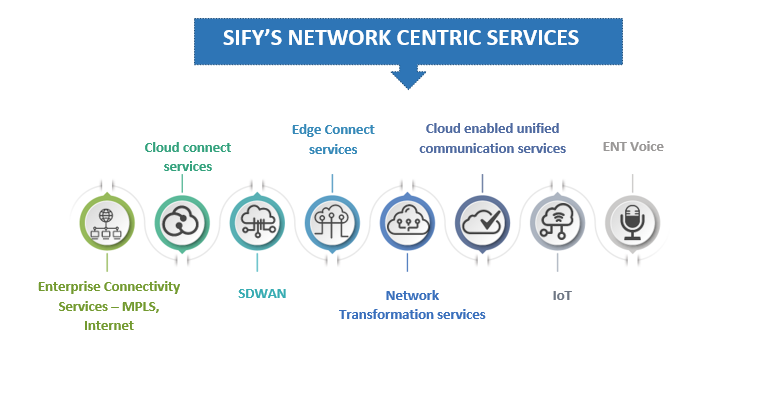
Embarking on a successful Microsoft Cloud journey with Sify
In the digital age, migration to Cloud has become the top-most priority for businesses across realms. We are seeing major shift in the number of ‘Cloud Hostile’ customers turning into ‘Cloud Friendly’ & ‘Cloud Ready’ customers and pondering on the best plan to implement the migration successfully.
One of the major reasons behind this trend – besides performance, security, and cost – is agility & flexibility which help in faster business innovations. Organizations have started transforming themselves digitally to drive business value and grow business with enhanced end user experience.
Over the past few years, Microsoft has earned massive popularity among organizations worldwide for being a leading Cloud provider with – Azure, Microsoft 365 (M365) and Microsoft Dynamics 365.
Microsoft Azure is a highly productive, hybrid, and intelligent Cloud that allows you to leverage the power of cutting-edge digital technologies to build, deploy and manage critical applications as per your company’s requirements. It also provides Cloud enhanced services like AI/ML, RPA, Analytics tools, and integrated Cloud resources to make your organization more agile and improve top-line performance.
Considering the above benefits, many forward-looking businesses are exploring Cloud-powered services to optimize internal processes and generate new business models. However, this digital aspiration is incomplete without transforming the technology landscape first. A strong technology foundation provided by Microsoft will help you connect your disparate data, processes, users, and applications to accomplish the end objective of organizational excellence.
Achieving all these is not as simple as it may seem initially! That’s where, Sify’s consultative approach can help you leverage the true value of Microsoft Services and align your organizational roadmap with the ever-evolving technology landscape.
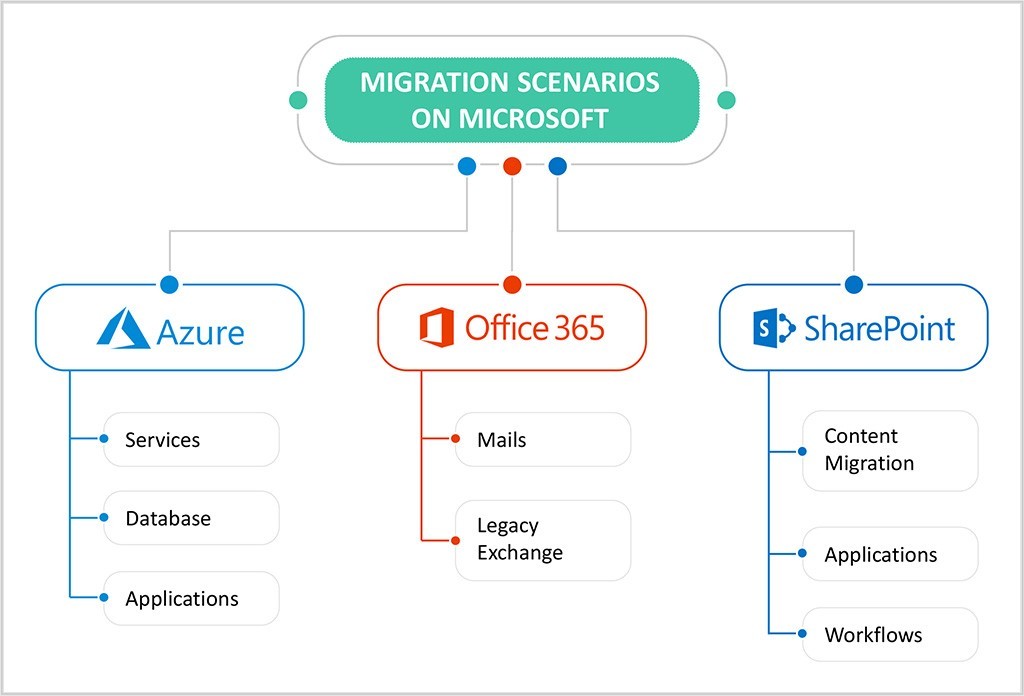
Azure Migration: The most successful path
Different organizations have distinct approach towards Cloud migration, and their decisions are governed by business specific priorities and constraints. You must know that Cloud migration involves significant organizational change management across people, process, and technology. It’s very important to draft a holistic approach to migrate successfully and realize the benefits of efficiency, agility, and cost.
With Sify as your strategic partner, you are perfectly positioned to draft, implement, and monitor the overall migration plan in the most successful way. Our team of Cloud experts, Azure certified professionals, cutting-edge toolchains, and partner ecosystem can help you accomplish migration goals successfully. We can help you across all three phases of migration – assessment, migration, and optimization.
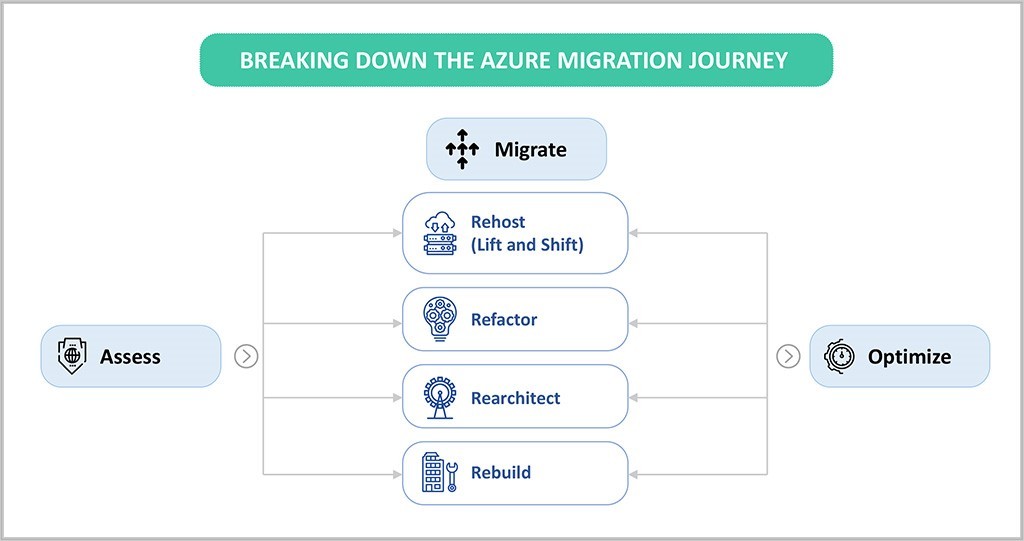
Assessment: This is the first phase of migration journey, which includes assessing and discovering your on-premises apps, data, and infrastructure. Our comprehensive range of assessment services can help you map dependencies across applications and decide their priority of Azure migration for a seamless journey.
Migration: The actual migration begins in this phase, where you start moving your apps, data and infrastructure – leveraging the best-suited migration strategies and tools. Our migration services will help you automate the entire migration journey (depending upon your IT specific needs) and minimize the downtime.
Optimization: Once you have moved to Cloud, it becomes important to monitor your Cloud resources continuously for better performance, enhanced security, and reduced cost. Our services will help you maximize your ROI and leverage unified visibility of Cloud resources for efficient resource utilization and optimization.
Sify + Azure Advantage
- Single window solution provider (Network, Security, Azure IT and Management)
- End-to-end Azure service coverage: Access – Architect – Migrate – Manage – Secure
- Integrated Azure network and security proposition
- Unified Dashboard across Azure IT
- Simplified Execution and single point of ownership
Know more about transforming your IT Infrastructure with Sify’s Azure capabilities.
Microsoft 365 – Mail migration
With Office 365 becoming the de-facto mode for conducting business, it is important to modernize the underlying infrastructure and platform. It is imperative for enterprises to move their legacy exchange and other mailboxes to Office 365 in order to reap full benefits of their workflow optimizations. Additionally, Office 365 offers the benefit of pay per use pricing for optimizing cost.
So in case, you are exploring the possibilities to conceptualize and implement your cloud migration in the most success-driven manner, Sify can help you embark on a successful Microsoft Cloud journey.
Our Accreditations
- Microsoft Certified Partner for Cloud & Managed Services
- Certified Deployment Partner for deployment of M365 & Azure services
- Express Route Partnership for seamless connectivity with MS Cloud Azure & Microsoft 365
- Certified team for Migration & Deployment of MS SQL workloads
- Certified team for deployment of Hybrid Cloud Platform











